Tattoos of Indochina: Supernatural Mysteries of the Flesh
Article © 2109 Lars Krutak
Tribal Tattoo Traditions of Myanmar, Vietnam, and Laos
Apart from the magical tattoos of the Theravada Buddhist tradition, several indigenous tribes inhabiting Indochina also practiced unique forms of facial and body-marking. Allegedly, the practice among the Chin, Ashö, and Dai of Myanmar was developed to discourage slave traders from kidnapping the beautiful women of these areas “for the Burmese king.” Of course, the Chin themselves state that a woman’s facial tattoos made her more beautiful in the eyes of the beholder making the previous (and longstanding) explanation difficult to justify.
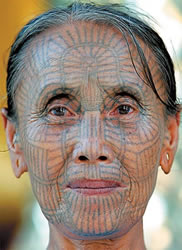 |
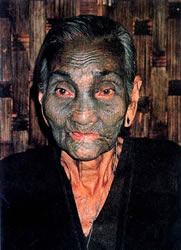 |
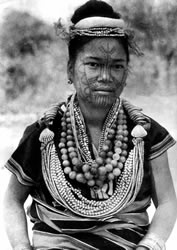 |
|
Laytu Chin woman, Myanmar. Laytu girls were tattooed before marriage and usually by men. Their facial tattoos are comprised of complex geometric patterns and resemble the weave structure of a fine textile.
In other regions of aboriginal Burma, pigmented stencils were first applied to the skin and then pricked in with thorns from a lemon tree, bamboo, or sharpened porcupine quill. Pigments were derived from soot or the fermented juices of local bean plants. |
Heavily tattooed Ashö woman from Myanmar. |
Northern Chin woman of the Chinbok tribe, Myanmar, ca. 1930. |
The Chin, like Theravada Buddhists across Indochina, also held great feasts and performed animal sacrifices to “make merit.” Instead of offering earthly goods to Buddha to ensure positive karma, the Chin attempted to gain status in the present world and in the afterlife by appeasing their household (ancestral) and village spirits with ritualistic offerings. These “feasts of merit” as they are called were held to not only benefit the hosts of the party, but also their family and ancestors. At the same time these gatherings enhanced the status of the household through the display and redistribution of wealth (e.g., household goods and food, especially mithan meat), and were believed to contribute to communal fertility.
The mithan (Bos frontalis), a kind of buffalo, is considered to be the most valuable possession of any Chin, and a person’s wealth is determined by the number owned. Any feast of merit or other celebratory feast, like those held for large harvests or the killing of a large animal (e.g., tiger or elephant), required the sacrifice of at least one mithan because the spirits accorded them with the highest sacrificial value.
Although there is very little literature on the practice of Chin tattooing (an unfortunate fact although American Baptist Missionaries invaded the region around 1900), I believe that in antiquity a celebratory feast involving a mithan sacrifice was held for the girl to be marked. The reason I say this is because the indigenous Naga who live to the north of the Chin - in Myanmar and India - used to celebrate a girl’s first tattoos with the sacrifice of a mithan (there it is called mithun). Among the Naga, the celebratory feast that ensued was like a feast of merit because the family of the tattooed girl bestowed gifts of food and other goods to the attendees. In turn, they displayed their status and wealth to the community. Also, the cost of receiving a Naga tattoo (or a Chin tattoo for that matter) was high by local standards and not every girl or her family could afford to pay for one.
Nonetheless, the Chin did sacrifice animals including mithan to determine whether a proposed event such as a marriage, birth of a child, war campaign, or selection of a new village or house site was propitious. Animal sacrifices were also performed to ensure a good harvest or to cure illnesses and end periods of misfortune like drought.
Although Chin women continue to wear the extremely elaborate facial markings of their ancestors, the government effectively banned the painful practice in the southern Chin regions in the 1950s and more recently in the remote northern Chin areas in the 1990s citing “health concerns”. Nevertheless, each Chin group employed its own specific tattoo design and you can clearly determine where a woman is from based on her facial tattoo signature if you know how to read it.
Women of the Mang tribe of Vietnam also wore tattoos on their faces. Called khuoi luong these markings were necessary for an easy journey into the afterlife. If a woman was not marked with them before her death, it was believed that her ancestors would burden her with difficult labors. In turn, her tormented soul would cry out to her living relatives on earth to lighten her heavy load.
Laven and Katu women inhabiting the Bolaven Plateau of southern Laos were inscribed with facial and corporeal tattoos, and so too were Katu men. But not since the 1920s did members of both tribes have their faces cut with the thorns of the acacia tree and soot rubbed into the incisions as a rite of passage into adulthood.
More specifically, the Katu, who also live in parts of Vietnam, employed a popular motif called the “dancing lady” or padil yaya in their tattooing arts. The motif was inked in the middle of the forehead or on other parts of the body, and was also incorporated as a decorative element in textiles, the community house (guol), sculptures at the village gate, and gravestones. But the symbol was also the name of a dance of the same name that was performed during major animal sacrifices, agricultural and rain prayer ceremonies, as well as headhunting rituals (e.g., celebrations for the return of successful warriors).
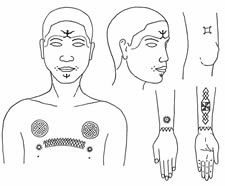
|
| Illustration of the femme qui danse and other Lawae tattoo designs, ca. 1950. |
The French scholar Bezacier (1951) stated that padil yaya tattoos were not literal examples of a dancing woman; rather they symbolized a device that protected the human soul. Bezacier documented that Katu men typically wore these designs, not women, in the belief that it safeguarded them from diseases brought by evil spirits. A secondary function of the tattoo was that it provided those who wore it with wisdom and good fortune, and generally speaking village leaders, who were male, were the recipients of the tattoo.
Other researchers now suggest that the “dancing lady” has a deeper significance because it ultimately symbolizes “Mother Rice,” a major agricultural deity in the Katu pantheon. When compared to the choreography of the sacred padil yaya dance, the characteristic features of the tattoo motif can be deciphered: because during the dance, which continues to be performed to this day, the women’s hands face the sky in an attempt to petition the gods of heaven and the earth for their favors.
Because the Katu are traditionally swidden (slash and burn) agriculturalists who do not use fertilizers and rely upon nature to provide their life giving rains, they created the padil yaya dance as a beautiful offering to please the gods. They also incorporated the symbol of the “dancing lady” or Mother Rice in all of their material arts as a permanent prayer to her. Thus, the village house (guol) where many community rituals took place was adorned with a great many padil yaya drawings. And when the “festival of the new rice” (cha avi teme) and seedling festival were held each year, a new guol was inaugurated, or when there was an outbreak of disease or famine, or there was a grave building or headhunting ceremony, the padil yaya was always danced.
More specifically, the padil yaya was danced during the seedling ceremony to implore the gods for a successful crop and harvest. In the festival of the new rice, rice seeds were placed on the dancer’s hands as an offering to the gods, especially Mother Rice – the god of rice. During a successful headhunting campaign, the padil yaya was performed to give thanks to the gods who ensured that the Katu warriors met with no injury on their military campaign.
In big festivals, the “buffalo stabbing ritual” accompanied the padil yaya dance. This rite involved six women spinning their bodies while moving rhythmically on their tiptoes around a pillar (sinuar, “buffalo stabbing pillar”) in the center of the village where the animal sacrifice was made. Meanwhile, six men with shields and javelins performed the tantung, a hunting dance. One recent visitor to a Katu village in Laos recounted the sacrificial ceremony and dance of the men:
During the ceremony, the men of the village don wooden masks, hoist spears and wooden shields, and dance around the buffaloes in the center of the circle formed by their houses. After a prescribed period of dancing, the men converge on the buffaloes and spear them to death. The meat is divided among the villagers and each household places a piece in a basket on a pole in front of their house as a spirit offering.
Interestingly, this ceremony reminds me of the “merit making” activities of the Chin of Myanmar. But then again, buffaloes are sacrificed across Indochina and South East Asia as an offering to the spirits with the purpose of calling upon the divine powers of universe to protect and bless the human communities under their supervision.
The Laven (sometimes Lawae), a related and neighboring tribe of the Katu in Laos, continue to wear facial tattoos. However, only the women of the group own them and surprisingly these designs closely parallel the padil yaya tattoos worn by Katu men. Although both groups speak languages belonging to the ancient Mon-Khmer family, what is not known is why each group specifically restricted the tattoo motif to the female (Laven) or male (Katu) gender. Another difference is that some Laven women also wear Buddhist verses and kathas on their backs or other body parts whereas this custom is more restricted among the Katu. Typically these patterns were abbreviated to a few keys letters in Sanskrit, a typical Laotian custom, which either stood by themselves or were encircled or squared in mystical diagrams.
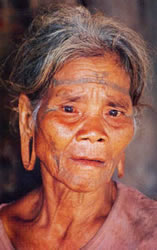 |
|
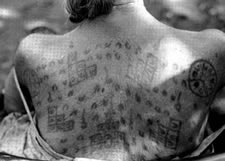 |
|
Lawae woman from Laos with “dancing lady” (pâdil-ya ya) tattoos on forehead. Illustration of the dancing lady and other Lawae tattoo designs, ca. 1950. Photograph © Michael Laukien. |
|
Lawae woman with protective Sanskrit letters encased in diagrams to protect her from bullets, biting animals, and other dangers from all directions. Photograph © Michael Laukien. |
Next Page | 1
|
2 |
3 |
4 |
Museum photo gallery of the images
on this page may
be seen here. |






